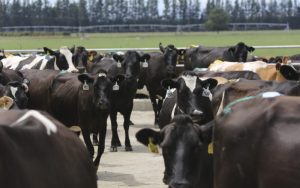
China’s issues are New Zealand’s issues. Focusing only on China’s dairy market, 2022 has been a tough gig for China’s dairy farmers and processors. Covid-19 and the Chinese response to it have created issues, which has rapidly changed that country’s dairy market.
Consumption is falling, while milk production has increased significantly during the global pandemic. Let’s look at what 2022 has meant for the Chinese market, how 2023 might also look, and most importantly, what that means for NZ.
Recently there have been reports from across China that cows are being culled, and raw milk dumped because of poor demand, a result of a year of significant milk production growth. As a result of this excess production, the average raw milk price in China continues to slip lower, with the raw milk price reported for December down 4.2% year on year, and the average 2022 price 2.9% lower than the first 11 months of 2021.
Some Chinese commentators expect the local raw milk price to fall a further 7.8% if supply and demand conditions continue. Concurrent with the falling milk price, milk production in China continues to ramp up, with reports of milk production growth for the 11 months to November 2022 about 10% higher than the same period a year before.
This 10% increase in milk production coincides with a reported reduction in total dairy consumption of about 4.9%. Consumption of liquid dairy is down 5.8% year on year in November, while consumption of milk powders was down 12.6% year on year in the same month.
This significant oversupply of local dairy in China is one of the key drivers of reduced commodity prices during 2022, as Chinese buyers required significantly less imports to cover demand. The easiest way to measure this oversupply is to compare the volume of whole milk powder reported in storage – in November 2022 WMP stocks were 35% higher than November the year before.
So, 2022 has been a year of milk production growth, along with a slide in consumption, attributed to Covid-19 infections and the related control of the infection. This means that for 2023, inventories are well stocked, and consumption needs to return to recent “normal’” levels for the Chinese dairy market to require significant imports.
Economically, things are looking positive again in China in the medium to long term, with most economists modelling that the removal of the Covid-zero policy will create an increase in overall consumption at some point in 2023. Some predict this response will happen in the second quarter of 2023, others think later in the year.
Other indicator commodities are already showing signs of increased demand. Iron ore imports have increased over the last month, while oil consumption in China is expected to bounce again after a dramatic fall immediately following the removal of the Covid-zero policies. These signals show that the Chinese economy is returning to normality, slowly, and the world can expect it to be back to somewhat normal in the medium-term.
We all know that NZ dairy exports to China in 2022 were significantly weak, and even though comparative figures in 2023 will look better than they did in 2022, it will take some time for Chinese buyers to return to the NZ market as they were during 2019, 2020 and 2021. But the likelihood is that as consumption increases, so will dairy imports.
What does this mean for NZ dairy?
The market should turn more positive at some point in 2023. The Chinese market needs to again increase local consumption to levels measured early in the Covid-19 pandemic, plus a bit more. The extra volume of milk now produced in China also needs to be consumed before Chinese dairy processors look for extra imports.
Oversupply in China is likely to create an issue for at least the first half of 2023, which will likely continue to blunt Chinese interaction with the global dairy market. Global dairy prices are likely to rebound, but not to the highs the market registered during 2021, that might take more than a year. Farm gate milk prices will remain under pressure as our biggest trade partner gets back on its feet, not to mention the impact of a likely recession for the bulk of global economies. I’ll take a peek into what a recession might mean for dairy in the next article, as the world might have decided if that’s going to happen or not by then…
Stuart Davison is a dairy analyst for NZX.
























